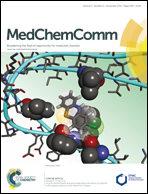1-[(2E)-3-Phenylprop-2-enoyl]-1H-benzimidazoles as anticancer agents: synthesis, crystal structure analysis and binding studies of the most potent anticancer molecule with serum albumin†
Abstract
A series of 1-[(2E)-3-phenylprop-2-enoyl]-1H-benzimidazoles have been synthesized and their ability to inhibit the growth of cancer cell lines has been investigated against an NCI 60 cell panel. The compound 1-[(2E)-3-phenylprop-2-enoyl]-2-(4-chlorophenyl)-1H-benzimidazole (compound 3f, NSC: 773404/1) was found to display good antitumor activity against the nine tumor subpanels with selectivity ratios ranging from 0.79 to 1.53 and from 0.47 to 1.69 at the GI50 and TGI levels, respectively. Structural parameters of the potent anticancer active compound, 3f, have been studied from single crystal XRD data. Further, the in vitro interactions of 3f with the transport protein, human serum albumin (HSA), were investigated by spectroscopic techniques. A static quenching mechanism was seen in the binding of 3f to HSA. Thermodynamic parameters revealed that hydrogen bonding and van der Waals forces played a major role in the interaction process.
![Graphical abstract: 1-[(2E)-3-Phenylprop-2-enoyl]-1H-benzimidazoles as anticancer agents: synthesis, crystal structure analysis and binding studies of the most potent anticancer molecule with serum albumin](/en/Image/Get?imageInfo.ImageType=GA&imageInfo.ImageIdentifier.ManuscriptID=C5MD00293A&imageInfo.ImageIdentifier.Year=2015)

 Please wait while we load your content...
Please wait while we load your content...